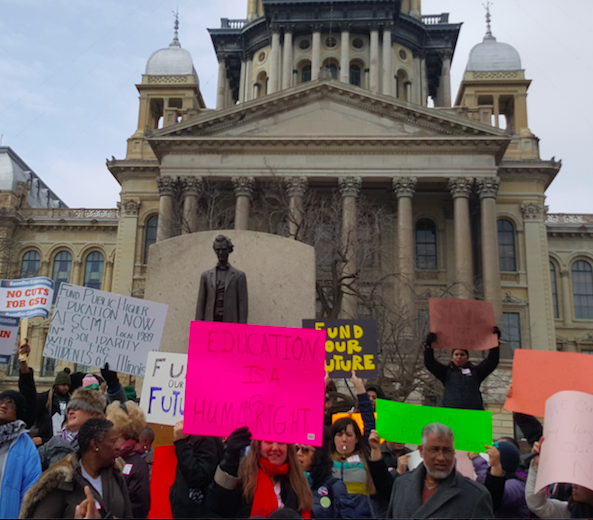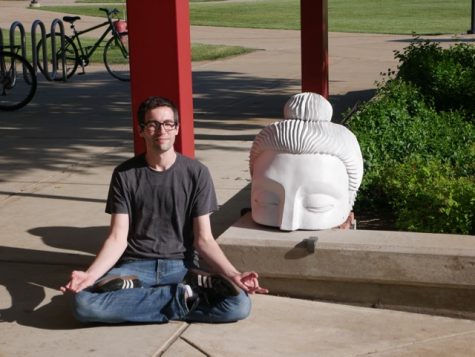What, the furlough?!
With looming decisions, a budget impasse and furlough programs, how will the administration bring NEIU into 2018?

NEIU faculty and staff went to Springfield to protest the first round of furloughs and are now experiencing the same thing again.
April 4, 2017
The university is rapidly approaching a financial wall. The administration and faculty are working to reduce it to a speed bump. It won’t be an easy journey but by working together both seem convinced that NEIU’s future is bright.
For the past two years NEIU instituted furlough programs as a way to absorb some of the financial impact of the budget impasse in Springfield.
Faculty and staff received seven weeks of 20 percent furloughs last year. So they lost one week of pay but it was spread out over nearly two months.
The only imposed furlough days so far this semester have been the five days during Spring Break.
“At the end of January when we looked at our cash flow, we discovered a shortfall in our general operations budget,” said Michael Pierick, NEIU CFO and Vice President for Finance and Administration. “When the so-called ‘Grand Bargain’ fell apart, we realized that we would probably not get any more state appropriations for this fiscal year (ending in June).”
The general operations budget accounts for the day-to-day operation of the university: primarily instruction and maintenance. The revenue for this budget is tuition and state appropriations.
The shortfall was about $8.2 million.
So the administration looked into the university’s savings. This included savings from the hiring and spending freezes and certain allocated money (for instance, $500,000 is set aside for deferred maintenance items such as emergency roof or sidewalk repairs) that have not been used.
After factoring in all of these various savings, there is still a shortfall of about $2.8 million to make it to the end of the fiscal year in June.
The administration also projected forward into the upcoming fall semester and we will be looking at another $16.7 million shortfall between June and Sept. 30.
After federal financial aid is posted in September and tuition money starts flowing in, a good deal of this will be absorbed, but there will still be another deficit to account for in the fall. Typically this is when NEIU would receive its state MAP grant appropriations but instead the university has had to front them to eligible students for the past two years.
“We also have a problem, though, in making it to Sept. 30,” said Pierick.
The problem: his office has to make payroll for the Sept. 15 payday. But financial aid is not posted until after the enrollment census data, which is taken the 10th day of classes, Sept. 12.
This is the period in which aid money is awarded from the state to the university based on course enrollment, since many students add and drop classes during this period.
Since federal financial aid gets posted on Sept. 12 and there will not be enough time to hit the payroll on Sept. 15.
Executive Vice President of NEIU/UPI 4100 and English Department faculty member Tim Barnett said, “The worry is that they’re just going to keep taking money … and we want to figure out a way to more appropriately respond to that, other than just saying, ‘Here, take our pay.’”
Three of the university’s five unions — The Teamsters Union (whom represent NEIU’s building service workers), International Union of Operating Engineers and Metropolitan Association of Police— have requested as part of their negotiations, “irrevocable intent to retire” contracts which would exempt retiring employees from the furloughs, in order to preserve their pensions.
These contracts are also being offered to administrative and professional employees of the university and non-negotiated civil service staff (those not represented by a union).
However, negotiations with UPI and American Federation of State, County and Municipal Employees are ongoing.
“We’ve been teaching, we’ve been doing research, we’ve been contributing to this university in all kinds of ways,” Barnett said. “We want to have a significant voice in how we are able to teach, what we are able to teach and how the university works.”
To complicate things further, the Department of Education has not changed the limits that students can borrow in several years. So especially with freshman and sophomores— whose loan limits are smaller than juniors and seniors— private borrowing is increasing each year. Last year there were $704,000 in private loans and this year the total is $846,000, so far. And these are just the students who are borrowing over their annual Stafford loan limits.
Financial Aid Director Maureen Amos said the silver lining is that state grants such as MAP are a political asset too valuable to be eliminated. So while we may not have an established state budget, MAP funding will never disappear.
The maximum MAP grant an NEIU student can earn for a year is $4,133 ($2,067 per semester if enrolled for 15 credit hours and $1,653 per semester for 12 credit hours)
“At one point, MAP used to cover all tuition and fees but it’s been over a decade,” Amos said.
State appropriations have been decreasing significantly over the last few years and the university has been fronting this money to students since the beginning of the budget impasse and billing the state afterward.
The peak year for appropriations was in 2002, when the university received $45.5 million. By fiscal year 2015, that number had been reduced down to $37 mil. Additionally, with inflation, costs have increased so tuition has increased as a result. This year, the state appropriation was $31.4 million (based on the governor’s recommended budget and what had been planned on during the annual budget planning for NEIU) but we have only actually received $19.6 million.
Since fiscal year 2015, budget revenue has been 60 percent tuition and 40 percent state appropriations.
“Those numbers have flipped,” Pierick said. “Fifteen years ago it was 60 percent state appropriations and 40 percent tuition dollars, so if you’re wondering why tuition has gone up, that’s the primary reason.”
In 2014, the university received $8,023,431 in MAP grant funding. In 2015, it received $7,425,351. In 2016, it received $6,489,753.
There are a lot of variables with the dollar figures. It is entirely based on eligibility, so MAP funding depends on enrollment from year to year.
Using February totals comparing 2016-2017, FAFSA applicants increased by 3 percent, Pell Grant recipients went up 19 percent and direct loan borrowers went up 39 percent.
The introduction of student housing and changes in status for grant eligibility contribute toward some of these fluctuations as well.
As part of the Money group, one of the four groups that comprise the Forward 150 initiative, Maureen Amos has been looking at trends at other universities.
Many institutions are incorporating an aspect of fundraising into their financial aid director positions, since they are in the best position to be able to identify areas of financial need.
Some companies are actually looking for students to give scholarships to. Amos said that an NEIU student once wrote Comcast a letter requesting a student discount on their service and was awarded a $20,000 scholarship—paid over four years— since no one had applied for it.
“There are regulations that require them (corporations) to give back to the consumer,” Amos said.
Money is out there, even if the state is not releasing it.
Despite the financial uncertainties ahead, NEIU’s graduate programs are looking to expand.
Michael Stern, Dean of College of Graduate Studies and Research said, “There have been modest gains in graduate enrollment at Northeastern.”
The inaugural class of the university’s new Masters of Social Work program started fall 2016.
The College of Graduate Studies is also in the approval process of adding a new program.
The public health program is currently in the approval process of adding a master’s degree.
Stern says it interfaces well with a $17.4 million grant (over five years) from the National Cancer Institute. This grant would be a collaboration between NEIU, UIC and Northwestern University. The grant is meant to enhance the universities’ capacity to do cancer research and education across various disciplines.
“It will make a big difference for the communities in the Chicago area to have students like our students getting these degrees and then going out into the workforce in Chicago,” Stern said.
Pierick echoed that sentiment. He said that over the course of his career he has seen higher education politicized as both a public good and later as a private good.
“It is a public good,” Pierick said. “Yes, it benefits the individual, but it also benefits society in general.”
In response to those who have politicized higher education as a private good, Barnett said: “My sense is that the state and government has really gained much more control over K-12 over the last 10 years and they want it over higher ed. They definitely want to make us more vocational.
“The more they weaken us — the more they take away — the more ability they have to get rid of those kinds of things (non-vocational programs) and then keep the programs that are much more business friendly. What’s getting in the way of that is tenure and unions.”
And faculty find themselves in a tricky position, caught between maintaining the party line of the university and advocating for more comprehensive solutions.
“On the one hand, we want to make this a great environment for students no matter what happens,” Barnett said. “We don’t want to send people away or give them the message that we’re not going to be open, or that pay cuts are going to mean that Northeastern won’t exist. At the same time I think there’s a lot of concern that most of the time students don’t really know there’s a problem, and we want to get them involved, talking with their representatives and Senators and working with us to fight back because this isn’t just about our jobs, it’s about their education. Those things are completely intertwined.”
Both Pierick and Amos remain confident that the budget impasse is a temporary setback.
“We will have been open for 150 years this fall,” Pierick said. “And we will be here for another 150 years.”
Amos said: “One of our biggest things here, is to keep morale up and let staff know that they’re doing good things and that a budget impasse, or budget cuts or furloughs are not a reflection on the job they do.”








